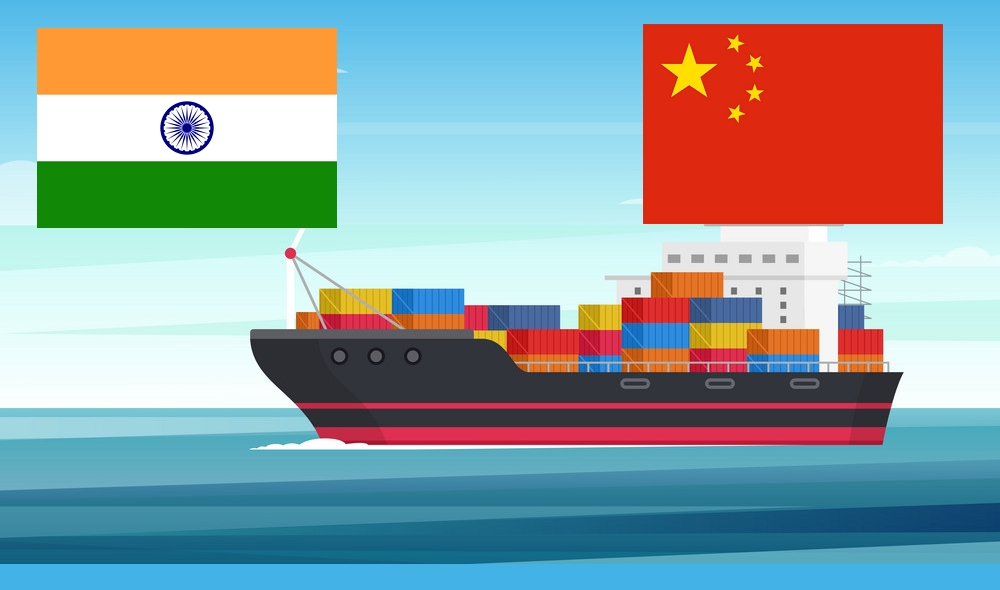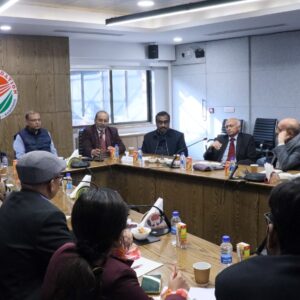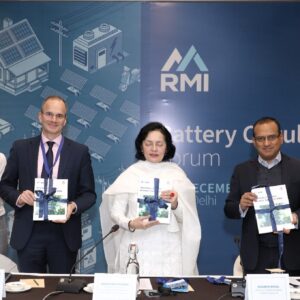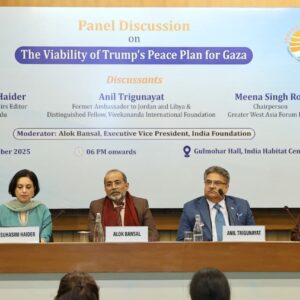The dominant paradigms for understanding international relations, particularly after the end of the Second World War, have been realism and neorealism. Given the numerous conflicts that have ravaged the world, the international relations community desperately sought to understand the root causes of these conflicts so that they could be avoided. Human nature was seen as one of the most important causes behind the conflict-seeking behaviour of countries in the international system. However, this alone was insufficient, leading to the emergence of neorealism. The dominant cause was now understood to be the anarchy within the international system, or the absence of a central authority capable of enforcing norms and rules. Given that states are acutely aware of their sovereign status, stemming from the signing of the Treaty of Westphalia, bartering away their sovereignty and the most supreme functions of governments was unacceptable.
As a result, despite the establishment of an organisation like the United Nations, the enforcement of norms and rules could never truly occur, leading to the prevalence of ‘anarchy’ and compelling states to prioritise their national interests above all else. In this context, liberalism emerged, focusing on finding mechanisms to avoid conflict. The priority areas envisaged by the liberal international relations theory included creating mutual dependencies through trade and investment, which would reduce the impetus for military disputes among states. As countries in the 1970s and early 1980s recognised that economic prowess could no longer be viewed solely as an aspect of soft power, the necessity for creating mutual dependencies through trade and investment also arose.
Trade and investment have contributed to improving development indicators in various countries. This has allowed nations, by leveraging their economic growth rates and central roles as trade hubs, to increase in significance and potentially usher in multipolarity, starting from the late 1990s. Countries like India, China, and South Korea, to name a few, found themselves sharing the high table of decision-making in international relations. However, as time progressed, it also became evident that trade created dependencies, because countries possess comparative advantages in production, which subsequently become leverage points over others. The case of India’s trade with China is pertinent in this context.
As the U.S. renegotiates its role as the dominant player in the existing world order and leverages tariffs and trade to secure gains for itself first, prioritising its interests above those of friends, partners, and foes alike across the spectrum of international relations, countries are now desperately seeking stable partners in economics and trade. Despite being the world’s second-largest economy, China does not have an excellent track record of fair trade or granting equal market access to its partners. Thus, understanding how India navigates the tricky challenge of its trade dynamics with China and the U.S., neither of which has served as a role model for fair trade, becomes essential for grasping the geo-economic challenges of the current epoch in history.
While trade has often been viewed as a mechanism for reducing the potential for military conflict, the fact remains that due to tariffs, trade has also become a domain leading to ever-increasing economic and, consequently, political conflicts. In the current epoch of history in which the world is living, the concept of tariffs as tools to further one’s economic growth and agendas, directly at the expense of others, is particularly associated with the U.S., especially under Trump 2.0. However, the other great power in the system, albeit not yet the leader of the international system—i.e. China—is no different. India’s case study becomes relevant to understand better the evolving dynamics of trade, tariffs, and geopolitical contestation.
As one of the leading actors of the existing international order, India stands as an economic heavyweight in its own right. India’s USD 4.19 trillion nominal GDP ranks it behind only the U.S., China, and Germany.[1] The World Economic Outlook from the International Monetary Fund (IMF) projects growth of 6.2% in 2025, reinforcing India’s position as a global economic driver and the world’s fastest-growing major economy.[2] India has active trade partnerships with both the U.S. and China. The U.S. has remained India’s largest trading partner for the fourth consecutive year in 2024-25, with bilateral trade valued at USD 131.84 billion, while the country’s trade deficit with China widened to USD 99.2 billion during the same period. Generally, India has maintained trade surpluses with the U.S., while it has consistently suffered trade deficits with China. The following graphs, which show India’s trade with the U.S. and China over the last 10 years, offer a clearer picture of the nature of trade ties India has with the two leading players in the current international order.
Graphs 1 and 2: Comparing India’s merchandise trade with the U.S. and China, respectively
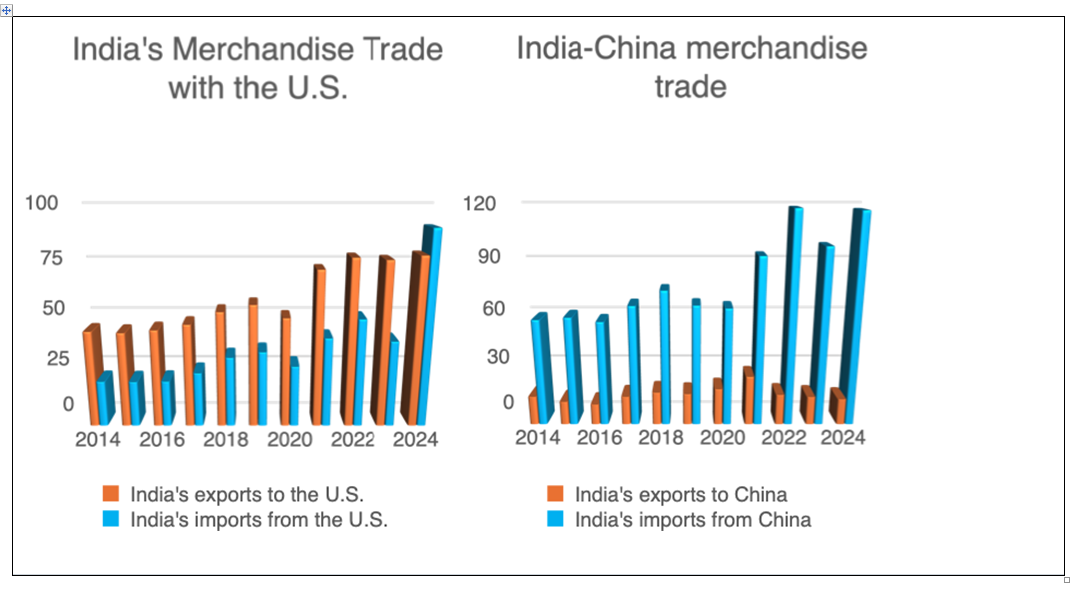 |
Source: United Nations COMTRADE database
As shown in graphs 1 and 2, India consistently maintained a trade surplus with the United States between 2014 and 2024, while running a persistent trade deficit with China. This contrasting trend warrants closer examination. India’s exports to China peaked at USD 28.14 billion in 2021 but declined sharply to USD 14.90 billion by 2024—a 14.5% drop from 2023 alone. Meanwhile, imports from China have risen steadily, from USD 55.31 billion in 2011 to USD 117.68 billion in 2024, reaching a high of USD 118.77 billion in 2022. India primarily exports iron ore, engineering goods, chemicals, and marine products to China, whereas its imports are dominated by electrical machinery, nuclear reactors, organic chemicals, plastics, and components.[3] Overall, bilateral trade between the two countries has expanded from USD 73.39 billion in 2011 to USD 132.58 billion in 2024.
Despite a dip in 2023, trade volumes between India and China remain robust[4]. Nevertheless, India has consistently experienced a trade deficit with China, which has widened drastically from USD 27.23 billion in 2011 to USD 102.78 billion in 2024. In the context of this trade deficit, it is pertinent to note that India has a limited export basket of iron ore, cotton, shrimps, and primarily agricultural products. However, market access barriers to Indian goods in China are severe. A crucial point here is that if India’s export basket is as small as assumed in its trade with China, why has expansion not occurred, especially when India exports these commodities and a much broader range to the U.S. and maintains a positive trade balance? The answer lies in analysing China’s tariff and non-tariff barriers against goods and services from India. China has imposed tariffs and non-tariff barriers on Indian goods and services, restricting market access for Indian exports, particularly in sectors like agriculture, pharmaceuticals, and IT services, where India has a comparative advantage.
China’s tariff barriers on key Indian exports
Tariff barriers are those barriers to trade that involve taxes or duties imposed on imported goods, thereby increasing their costs and reducing competitiveness. The following sections outline the key tariffs China imposes on Indian goods.
- Agricultural products: On Indian agricultural goods, such as sugar and rice, there are high Chinese tariffs. Tariffs on non-basmati rice and other agricultural commodities can range from 10% to 65%, reducing the competitiveness of Indian exports compared to domestic and other foreign suppliers.[5] Chinese tariffs on Indian sugar exports stand at around 50%, with additional safeguard duties applied inconsistently. This hampers India’s capacity to exploit China’s sugar demand, even though India is the world’s second-largest producer[6].
- Pharmaceuticals: India’s strengths in generic drugs are blocked by China’s tariffs, which average around 4-10% on pharmaceutical products. Active pharmaceutical ingredients encounter further barriers, diminishing cost advantages.[7] What should be highlighted for better context is that India exports pharmaceutical products to over 200 countries, including developed nations with strict regulatory standards. Currently, the U.S. is the largest destination for India’s pharmaceutical formulation products. Furthermore, India is a significant exporter of drugs (active pharmaceutical ingredients) and has 664 manufacturing plants approved by the U.S. Food and Drug Administration (USFDA)[8]. However, due to trade restrictions in China, Indian pharmaceuticals cannot access the market on equal terms.
- Textiles and Apparel: Indian textiles face tariffs ranging from 5% to 25%, with higher rates applied to value-added products such as garments. This hampers India’s ability to compete with countries like Vietnam or Bangladesh, which benefit from zero or lower tariffs in trade with China.[9]
- Pesticides: Starting from 7 May 2025, the Chinese government will impose anti-dumping duties on cypermethrin, a key pesticide ingredient from India. China’s Ministry of Commerce announced that the policy will be in effect for five years. The duties will range from 48.4% to 166.2%, depending on the Indian companies exporting[10].
The following table shows 5 out of 202 items from India traded with China and the tariff rates that China applies to them.
Table 1: Five representative products from India and China’s tariffs on them.
| Reporter | Year | Partner | Product | MFN Rate | Applied Tariff |
| China | 2022 | India | Fish; tuna, fresh or chilled, (excluding fillets, livers, roes and other fish meat) | 7 | 4.69999980926514 |
| China | 2022 | India | Swordfish (Xiphias gladius) | 7 | 3.5 |
| China | 2022 | India | Ducks | 5 | 5 |
| China | 2022 | India | Fatty livers, fresh or chilled | 20 | 20 |
| China | 2022 | India | Cuts and offal, fresh or chilled | 20 | 20 |
Source: World Integrated Trade Solution[11]. [12]
While tariff barriers restrict trade, they are easier to spot and understand than non-tariff barriers, which are opaque and applied arbitrarily. China’s non-tariff barriers (NTBs) significantly restrict Indian exports, particularly in pharmaceuticals, agriculture, and marine products.
China’s non-tariff barriers against Indian products
NTBs, viewed in a regulatory context, impose higher costs on trade than tariffs, and a significant challenge with NTBs is quantifying the affected trade. Indian officials from the Ministry of Commerce have repeatedly highlighted the issues India faces due to import surges from China, which harm the Indian domestic industry. Indian exporters encounter problems such as payment deductions and financial losses associated with the banking system in China, without sufficient clarification regarding the reasons for these deductions[13]. Indian trading companies have also accused Chinese steelmakers of backing out of orders for Indian iron ore, resulting in significant economic losses[14].
Issues encompass food and public health safety, as well as cooperation in science and technology. For instance, China refrains from purchasing rice from India, citing quality concerns[15], while importing from Pakistan and Myanmar without mentioning concerns regarding quality issues!
More than half of imports to China require import licences. Depending on the product, the initial licence is issued by various organisations, but the Chinese Ministry of Commerce grants the final licence. Consequently, it remains unclear which product or company will ultimately receive the licence, leaving Indian traders often at the mercy of these opaque processes in China[16].
The Institute of Chinese Studies created a table of Chinese non-tariff barriers against certain Indian products in 2017. The following table provides a clearer picture of the NTBs that China has against Indian products.
Table 4: Bilateral level NTBs imposed by China
| NTB Code | Description | Number | Percentage |
| P163 | Product quality, safety, or performance requirement | 1004 | 42.3 |
| A11 | Temporary geographic prohibitions for SPS reasons | 980 | 41.3 |
| A82 | Testing requirement | 281 | 11.8 |
| E32 | Prohibition for non-economic reasons | 35 | 1.5 |
| A86 | Quarantine requirement | 16 | 0.7 |
| A851 | Origin of materials and parts | 12 | 0.5 |
| C3 | Requirement to pass through specified port of customs | 8 | 0.3 |
| B83 | Certification requirement | 6 | 0.3 |
| B84 | Inspection requirement | 6 | 0.3 |
| A84 | Inspection requirement | 4 | 0.2 |
| E1 | Non-automatic import-licensing procedures other than authorizations for SPS or TBT reasons | 3 | 0.1 |
| E111 | Licensing procedure with no specific ex ante criteria | 3 | 0.1 |
| F61 | Custom-inspection, processing and servicing fees | 3 | 0.1 |
| P162 | Product quality, safety, or performance requirement before export | 3 | 0.1 |
| A14 | Special authorization requirement for SPS reasons | 2 | 0.1 |
| A51 | Cold/heat treatment | 2 | 0.1 |
| A69 | Other requirements on production or post-production processes | 2 | 0.1 |
| A83 | Certification requirement | 2 | 0.1 |
| B31 | Labelling requirements | 2 | 0.1 |
| F71 | Consumption taxes | 1 | 0 |
| Total | 2375 | 100 |
Source: Malini Tantri, C. Nalin Kumar and Varadurga Bhat, 2021[17].
Specific examples of China’s NTBs against Indian products
- Sanitary and phytosanitary measures and testing requirements: India’s agricultural exports, such as grapes, mangoes, chillies, tea, and basmati rice, face stringent SPS measures in China. These include complex testing and certification by Chinese customs, which increases costs and causes delays. High compliance costs deter small and medium enterprises from exporting to China, further reducing Indian exports. As far back as 2012, India had raised concerns that China did not provide sufficient scientific evidence for restricting exports of its agricultural commodities. Despite India having consistently raised the issue of market access for Indian agricultural products with China, there has been no inclination from China to resolve the matter, and the problem persists even in 2025[18].
- Pharmaceutical export rejections: Indian pharmaceutical exports to China often encounter rejections due to “non-compliance” with Chinese testing standards, which are, to say the least, unclear. Furthermore, no redress mechanism is in place, resulting in significant financial losses. In 2019, India requested that China open its pharmaceutical market, especially for affordable and high-quality generic drugs from Indian pharmaceutical companies. India also urged China to prioritise the resolution of various regulatory hurdles faced by Indian companies, including addressing the lengthy delays in product approval timelines, the lack of clarity in registration guidelines, drug procurement by local governments in China, suomotu approvals for those Indian pharma companies that have received approvals from stringent regulatory authorities like USFDA, EDQM, Japan, and ‘risk based’ batch testing with self-certification[19]. However, the situation in 2025 remains the same.
- Technical standards and quality control orders: China imposes stringent technical standards on Indian exports, particularly for food, meat, fish, dairy, and industrial products, where India holds a comparative advantage. These Chinese non-tariff barriers often diverge from international norms[20]. This highlights China’s strategy of denying exports while attempting to leverage the Indian market, all the while subtly refusing similar access to Indian products in China.
- Market access restrictions: Indian goods, particularly in the sectors of agriculture and pharmaceuticals, face barriers to entering the Chinese market due to opaque regulatory processes. Even 13 years ago, in 2012, China suspended the import of rapeseed meal from India because of alleged contamination with malachite green dye in shipments. Indian bovine meat and meat products were similarly refused entry into the Chinese market due to claims of foot and mouth disease. Access to certain vegetables and fruits from India was also restricted[21]. The situation remains the same even today.
China’s barriers to trade and its linkages with its geopolitical ambitions
In 2025, in the face of economic wrath from the U.S. in the form of tariffs, countries across the globe, including India and China, braced and continue to brace for economic catastrophes. While China has consistently used tariffs and non-tariff barriers against Indian products and denied equal market access, in 2025, when China was hit with the highest amount of tariffs by the U.S., it reached out to India, stating that India and China should stand together against the “abuse of tariffs” by the U.S.[22].
Yu Jing, the spokesperson for the Embassy of the People’s Republic of China in New Delhi, posted on X, “China-India economic and trade relationship is based on complementarity and mutual benefit.”[23] This marks the first time that China has made such a statement. What the PRC has conveniently forgotten is that it has imposed tariffs and non-tariff barriers against India for decades, without any redress, even when India has made specific requests for resolution.
China aspires to be the leading actor in the international system, displacing the U.S. However, its economic growth must continue for it to attempt to achieve some level of parity with the U.S. India is not regarded as valuable in this competition unless the Indian market needs to be leveraged by China to drive its own economic growth at India’s expense. Even within the framework of regional groupings such as the Shanghai Cooperation Organisation or BRICS Plus, China frequently highlights what it perceives as malicious trade practices of the U.S., often overlooking that it has engaged in the same practices, and even worse, against Indian products.
While India also suffers from the adverse effects of the weaponisation of tariffs by the U.S., the fact remains that India has maintained positive trade balances with the U.S. until now and has not experienced the same level of denial of equal market access as has been the case with China. As stated in previous sections, India has raised these issues with China, requesting equal market access. However, China has consistently chosen to turn a blind eye. In the current historical context, as the U.S. renegotiates its role as the provider of a stable international order, serious strains will be felt across the globe. While it is crucial to identify and highlight the malicious use of tariffs by the U.S., it is equally important to recognise that China has long engaged in such practices. Its reliance on NTBs, in particular, is noteworthy, as these barriers are difficult to counter. NTBs are often complex, less transparent, and rooted in national regulations and policies. Tariffs are explicit taxes on imports, whereas NTBs are subtle and challenging to identify, measure, and contest.
India has employed the mechanism of the World Trade Organisation to counter China’s dumping of products within its borders. Recently, India has also instituted anti-dumping duties on certain Chinese goods. China has called it “unfortunate.”[24], even though India has clearly stated why it is a move to protect its domestic industry. While China, under the guise of protecting its domestic industry, has been imposing tariffs and non-tariff barriers on Indian products for years, India’s similar actions do not sit well with China. This hypocrisy is further highlighted by China’s imposition of a 166% duty on cypermethrin from India, which the PRC claimed was a measure to safeguard its own industry. Conversely, when India takes the same steps, it faces criticism from China.
While trade could have been a great tool to keep political and military conflicts at bay, the fact is that trade itself has emerged as a realm for further conflicts, duplicity, and a selfish, one-sided pursuit of interests. China’s utilisation of trade to become one of the leading actors in the international system has been well documented. However, what remains to be demonstrated is how it has used trade for its own benefit, often at the expense of its trading partners, thereby ensuring that true globalisation can never fully take place. India needs to be cognisant of the fact that while the U.S. is resorting to weaponising tariffs, China has long abused the principles of fair trade.
Author Brief Bio: Prof. (Dr.) Sriparna Pathak is a Professor of China Studies at the Jindal School of International Affairs and a Senior Fellow at the Jindal India Institute of O.P. Jindal Global University. She can be reached at sriparnapathak@gmail.com.
References:
[1] Jain, Smriti. “Explained in Charts: India to Become 4th Largest World Economy Soon. What’s the Road Ahead to No.3 Spot?” The Times of India, 27 May 2025, timesofindia.indiatimes.com/business/india-business/explained-in-charts-india-to-become-4th-largest-world-economy-soon-whats-the-road-ahead-to-no-3-spot/articleshow/121418460.cms.
[2] India: Fastest-Growing Major Economy.
[3] Embassy of India, Beijing. www.eoibeijing.gov.in/eoibejing_pages/MjQ%2C.
[4] Embassy of India, Beijing. www.eoibeijing.gov.in/eoibejing_pages/MjQ%2C.
[5] Barik, Soumyarendra, and Ravi Dutta Mishra. “Govt Looks at Options as Business Mounts Pressure for China Dealings Again.” The Indian Express, 23 Oct. 2024, indianexpress.com/article/india/govt-looks-at-options-as-business-mounts-pressure-for-china-dealings-again-9633750.
[6] https://apps.fas.usda.gov/newgainapi/api/Report/DownloadReportByFileName?fileName=Sugar%20Annual_Guangzhou%20ATO_China%20-%20People%27s%20Republic%20of_CH2025-0086.pdf
[7] Singh, Sandeep, and Anil Sasi. “US Tariffs Looming, India Looks at Easing Non-trade Barriers, Relaxing Chinese FDI.” The Indian Express, 24 Mar. 2025, indianexpress.com/article/business/economy/us-tariffs-looming-india-looks-at-easing-non-trade-barriers-relaxing-chinese-fdi-9902293.
[8] Chaudhuri, Sudip. “India’s Import Dependence on China in Pharmaceuticals: Status, Issues and Policy Options.” RIS Discussion Paper Series, 268, July 2021.
[9] Suneja, Yogima Seth Sharma and Kirtika. “India Sees Export Opportunity in 10 Products Amid US-China Tariff War.” The Economic Times, 15 Apr. 2025, economictimes.indiatimes.com/news/economy/foreign-trade/india-sees-export-opportunity-in-10-products-amid-us-china-tariff-war/articleshow/120289496.cms?from=mdr.
[10] https://www.idnfinancials.com/news/54376/china-hits-back-at-india-through-166-anti-dumping-duty-on-pesticide#:~:text=BEIJING%20%E2%80%93%20The%20Chinese%20government%20has,pesticide%20ingredient%20originating%20from%20India.
[11] China Tariffs on India | WITS Data. wits.worldbank.org/tariff/trains/en/country/CHN/partner/IND/product/all#.
[12] Please see the complete list at https://wits.worldbank.org/tariff/trains/en/country/CHN/partner/IND/product/all#
[13] Ace Global Private Limited. “Trade Facilitation Problems of Indian Exporters.” Final Report, by Govt. of India, Ministry of Commerce & Industry et al., June 2005, wtocentre.iift.ac.in/UNCTAD/UNCTAD%20TFAC%20%20Final%20Report%2013%20June%202005.pdf.
[14] Peter Wonacott “Downturn Heightens China-India Tension on Trade”, Wall Street Journal, 20 march 2009, https://www.wsj.com/articles/SB123749113639187441
[15] Gupta, Yashi. “Explained: Why Is China Importing Rice From India for the First Time in Decades?” CNBCTV18, 17 Dec. 2020, www.cnbctv18.com/world/explained-why-is-china-importing-rice-from-india-for-the-first-time-in-decades-7757601.htm.
[16] Tantri, Malini L., et al. “Trade Irritants and Non-Tariff Measures Between China and India.” Institute of Chinese Studies, 2021, www.icsin.org/uploads/2021/06/07/9e51ae3fb07b4f54a7d5900d21ec9319.pdf.
[17] Tantri, Malini L., et al. “Trade Irritants and Non-Tariff Measures Between China and India.” Institute of Chinese Studies, 2021, www.icsin.org/uploads/2021/06/07/9e51ae3fb07b4f54a7d5900d21ec9319.pdf.
[18] Pti. “India Raises Concerns Over Agricultural Exports to China.” The Economic Times, 21 Mar. 2012, www.economictimes.indiatimes.com/news/economy/agriculture/india-raises-concerns-over-agricultural-exports-to-china/articleshow/12355807.cms?utm_source=contentofinterest&utm_medium=text&utm_campaign=cppst.
[19] Meeting of Drug Regulators of India and China. www.pib.gov.in/PressReleasePage.aspx?PRID=1578521#:~:text=Both%20sides%20also%20decided%20to%20work%20towards,CFDA%20to%20enable%20higher%20exports%20to%20China.
[20] Ananth, Venkat. “Seven Flashpoints Between India and China.” Mint, 24 Sept. 2014, www.livemint.com/Politics/PsdTIEaclnM6EkEMUrMGDP/Seven-flashpoints-between-India-and-China.html.
[21] Trade Between India and China. www.pib.gov.in/newsite/PrintRelease.aspx?relid=108614#:~:text=China%20has%20suspended%20import%20of%20rapeseed%20meal,of%20alleged%20’Foot%2Dand%2DMouth%20Disease’%20(FMD)%20in%20India.
[22] Anirban Bhaumik, and Anirban Bhaumik. “China Calls on India to Jointly Oppose US ‘abuse of Tariffs.’” Deccan Herald, 8 Apr. 2025, www.deccanherald.com/india/china-reaches-out-to-india-after-us-tariffs-abuse-proposes-to-stand-together-3484834.
[23] Sharan, Sunil. “China Is on Our Side. Really?” The Statesman, 12 Apr. 2025, www.thestatesman.com/opinion/china-is-on-our-side-really-1503419665.html.
[24] TOI Business Desk. “India Imposes Anti-dumping Duties on Five Chinese Products to Protect Local Industries.” The Times of India, 23 Mar. 2025, timesofindia.indiatimes.com/india/india-imposes-anti-dumping-duties-on-five-chinese-products-to-protect-local-industries/articleshow/119378432.cms#:~:text=India%20has%20imposed%20anti%2Ddumping%20duties%20on%20five,protect%20local%20industries%20from%20unfairly%20low%2Dpriced%20imports.&text=As%20both%20India%20and%20China%20are%20WTO,which%20reached%20USD%2085%20billion%20in%202023%2D24.


